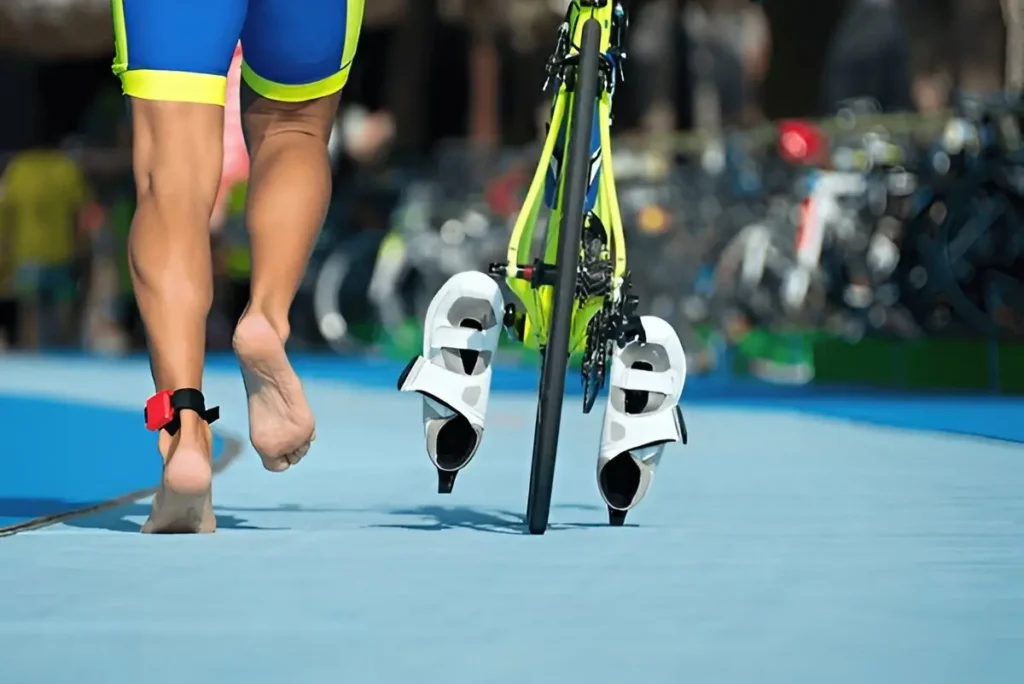Triathlons Cut off times are won or lost in the transition process—those chaotic moments between disciplines where precious time slips away. While race performance hinges on swim, bike, and run prowess, neglecting triathlon transition time optimization is a critical mistake. This guide reveals effective techniques to transform your triathlon transitions into seamless transitions, saving 2+ minutes and giving you a competitive edge.
Let’s keep in mind those ironman 70.3 cut off times:
| Discipline | Distance | Timit limit | Cutoff Time |
|---|---|---|---|
| 🏊♂️ Natation +T2 | 1,9 km | 1h10 | 1h10 |
| 🚴♂️ Vélo + T1 | 90 km | 4h20 | 5h30 |
| 🏃♂️ Course à pied | 21,1 km | Variable | 8h30 |

Why Transitions Are a Key Component of Triathlon time limit Success
Efficient transitions are the crucial aspects separating podium finishers from the pack. A polished bike transition (T1) and bike-run transition (T2) can propel you ahead without extra exertion. Consider this:
- A 30-second delay in T1 costs a 25-minute deficit over a 40km bike leg at 32kph.
- Elite athletes like Kristian Blummenfelt execute slick transitions in under 60 seconds by mastering transition strategies.
Let’s break down how to replicate their transition efficiency.
1. Transition Area Setup: Organize Your Transition Spot for Speed
A clutter-free layout is non-negotiable. Follow this pro-approved transition strategy:
Zone 1: Swim-to-Bike (T1)
- Bike Placement: Front wheel facing the bike exit, secured on the bike rack with shoes pre-clipped.
- Gear Order:
- Top of Towel: Helmet (straps open), sunglasses inside.
- Left Side: Cycling shoes (pre-attached with rubber bands for flying mounts) or laid out with elastic laces.
- Right Side: Rolled wetsuit, goggles, and cap.
Zone 2: Bike-to-Run (T2)
- Top of Towel: Race belt (with race bib facing forward), hat/visor.
- Left Side: Running shoes with speed laces, pre-loaded with nutrition.
- Right Side: Socks (optional), small towel for wet feet.
Pro Tips:
- Use a bright-colored transition mat to mark your spot in crowded rows of transition racks.
- Practice transitions during brick workouts to build muscle memory and simulate race conditions.
2. Wetsuit Stripping Drills: Escape in <20 Seconds Post-Swim Exit
The clock starts the moment you exit the water. Master these steps:
Step 1: Pre-Race Prep
- Lubricate ankles with Bodyglide to avoid common pitfalls like stuck wetsuits.
- Attach a plastic bag to your tri suit for rapid peeling.
Step 2: The 4-Second Peel
- Unzip while running to your transition spot.
- Pull the suit to your waist, then step on the leg and yank upward.
- Use the plastic bag trick to slide off wet feet effortlessly.
Transition Drills to Practice:
- Timed Stripping: Aim for 15 seconds during training sessions.
- Cold Hands Simulation: Practice with gloves to mimic race day numbness.
3. Cycling Shoes vs. Flying Mounts: Balance Risk and Reward
Your bike transition strategy depends on skill level:
| Method | Time Saved | Risk Factor | Best For |
|---|---|---|---|
| Shoe-Clip Pedals | 10–20 seconds | Low | Novice triathletes, technical courses |
| Flying Mounts | 30–45 seconds | High | Advanced athletes, straight exits |
How to Nail Flying Mounts:
- Pre-Clip Shoes: Secure cycling shoes to pedals with rubber bands.
- Mark Your Mount Line: Place chalk 10m from transition to cue your jump.
- Practice Dismounts: Train flying dismounts to avoid crashes at the bike exit.
Bonus Tip: Use cord locks on running shoes for slip-on speed.
4. Pro Tips from Elite Athletes: Secrets to Smoother Transitions
We interviewed professional triathletes for their transition techniques:
- “Double-Check Your Helmet” – Taylor Knibb: “A DQ isn’t worth rushing—buckle before touching the bike.”
- “Angle Shoes Horizontally” – Alex Yee: “For flying mounts, align cycling shoes for smooth entry.”
- “Ditch Socks” – Hayden Wilde: “Unless it’s freezing, wet feet dry faster without them.”
5. Mental Resilience: Stay Calm Under Race Day Pressure
A focused mindset is as vital as physical prowess. Use this logical sequence:
- T1: Wetsuit off → Helmet on → Grab bike → GO.
- T2: Bike racked → Helmet off → Running shoes on → Race belt → GO.
Avoid Common Transition Mistakes:
- Misplacing Gear: Organize transition items in advance.
- Overpacking: Stick to essential items—skip the extra bottle unless critical.
6. Transition Practice: Build Muscle Memory for Race Scenarios
Incorporate mock transitions into your training regimen:
- Brick Workouts: Pair strenuous cycling with 10-15 minute running intervals to mimic race environments.
- Agility Training: Use transition drills like “blindfolded gear grabs” to enhance speed.
Race Day Bonus: Arrive early to scout transition racks and visualize your transition sequences.
Final Word: Transitions Are Free Speed
Mastering the art of triathlon transition time optimization requires mental fortitude and deliberate practice sessions, but the payoff is monumental. Pair these strategies with our Brick Training Blueprint to dominate the cycling portion and running stage.
Now, go shave those minutes—your successful triathlon awaits.


Pingback: Triathlon Run Socks vs No Socks - besttriathletes.com
Pingback: Conquer Your First Triathlon: The Ultimate Beginner Triathlon Training Plan - besttriathletes.com
Pingback: Pedal to Perfection: Mastering the 70.3 Bike Cutoff Time for a Strong Finish - besttriathletes.com